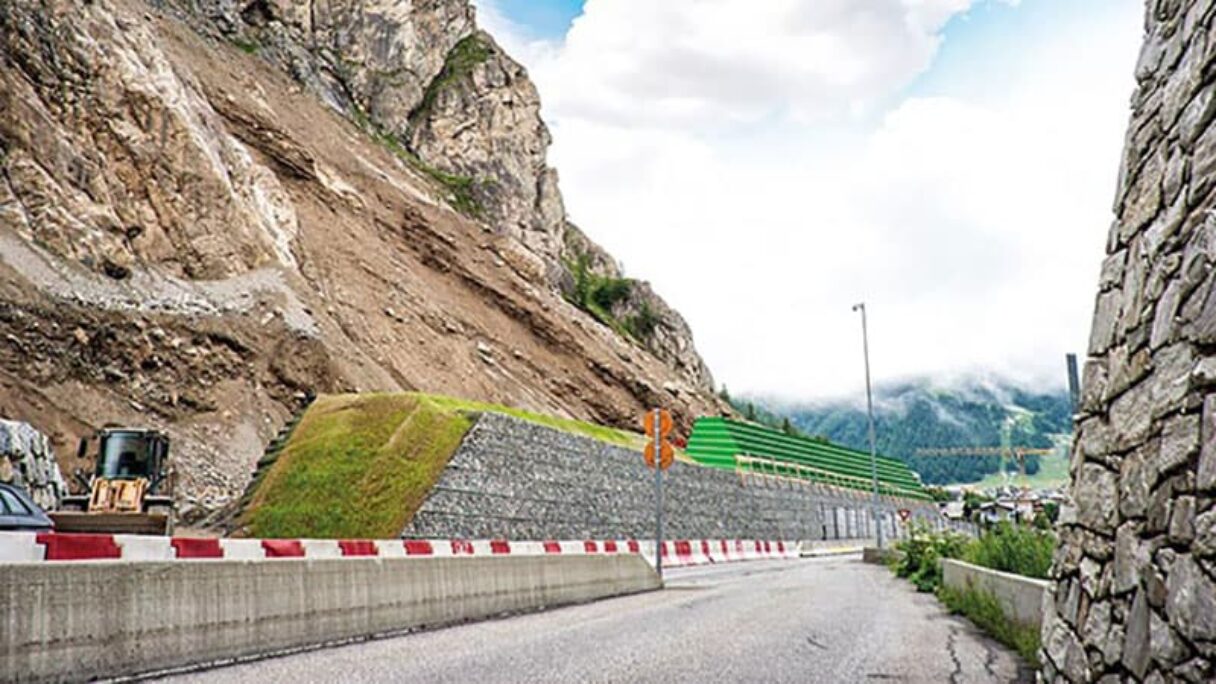Rockfall-protection bund provides one solution, three aspects in Val d’Isère

Naue Secugrid® geogrids enable optical and functional variants
The French Val d’Isère is famous as a winter sports area. But the beautiful mountains surrounding the valley, which is situated at an altitude of 1,800m, have a dark side: falling rocks! Naue Secugrid® geogrids helped enable a pro-tection bund to be constructed despite severe space limitations.
The district of La Daille posed the main problem. Increasingly, stones and boulders have broken away from the side of the mountain. They have plunged down onto the RD 902 main road, sometimes with enough energy to reach the buildings of the nearby village. The existing rockfall-protection wall was no longer sufficient, and more extensive technical safety measures had become necessary.
The particular challenge was to build the bund as high as possible on the limited space available. This necessitated a steep structure which, of course, had to be completely stable. In addition, the structure on the main road would have to meet high aesthetic requirements.
The uphill face of the existing rockfall-protection bund was therefore heightened and steepened to maximise the retention of falling boulders. And the length of the bund was increased. The design calculations and the execution plans for the entire construction project (with a length of 150m) were drawn up by the geosynthetic consultants BBG Bauberatung Geokunststoffe, Germany.
Structures reinforced with Naue Secugrid® systems proved to be the ideal solution
They offered three advantages:
- Reuse of local soils (thus, an ecological and economical solution)
- Greater flexibility in adapting to the terrain situation and to the construction requirements
- Aesthetic alternatives for the structure’s face
Three different aspects
On the uphill face, the structure has a slope angle of 65° and a maximum height of 7m. The slope facing was constructed using tyres. These are extremely robust when impacted by rocks. The Secugrid® geogrid reinforcement was placed every second layer of tyres, with a vertical spacing of 660mm.
On the face adjacent to the road, the wall, at its highest, is approximately 12m high and has a small berm. The lower 5m of the structure is sloped at approximately 79°. Here, the Secugrid® geogrids were laid with a vertical spacing of 680mm. The facing element was built as the NAUE-P system. The geogrids were wrapped around and a filter nonwoven incorporated to prevent soil erosion. In front of this, an approximately 300mm-thick stacked rock facing gave the structure a pleasing aesthetic finish. Permanent shuttering made of galvanised steel mesh is used over the total facing area.
The upper part of the wall, with a height of up to 7m, was executed as a steep slope with an inclination of 45° (1:1). The NAUE CLAMP system ensured the stability of this steep slope through utilization of Secugrid® layers at a vertical spacing of 660mm. The vegetated surface was protected using erosion-protection mats.
Four different grades of Naue Secugrid® were installed in Val d’Isère: Secugrid® 200/40 R6, Secugrid® 150/40 R6, Secugrid® 80/20 R6, and Secugrid® 40/20 R6.
